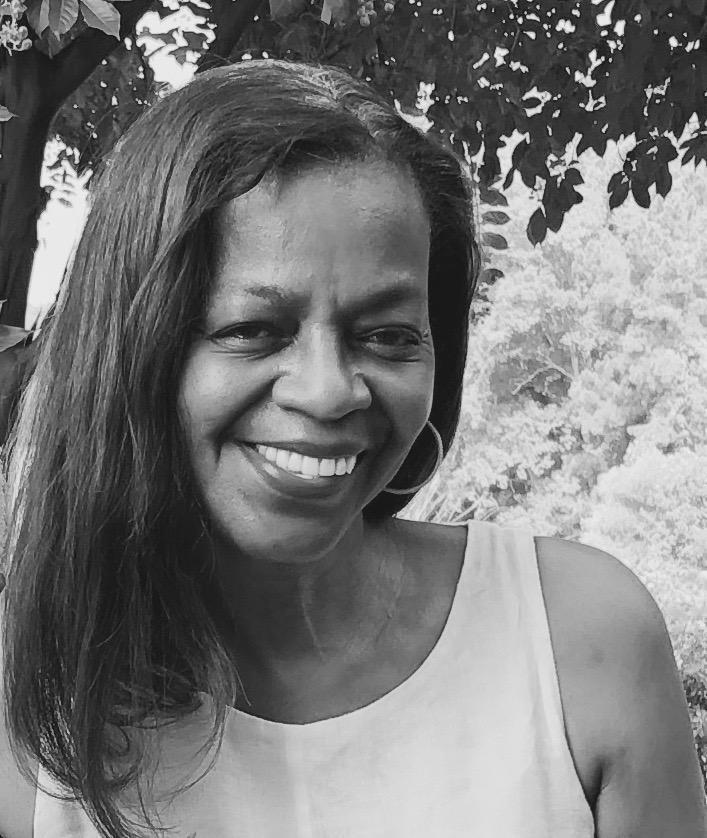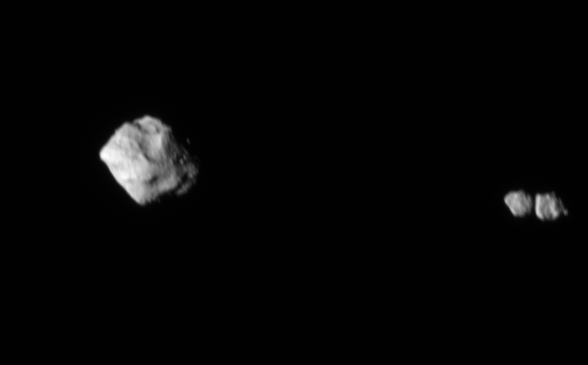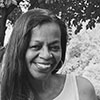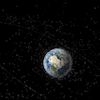 On November 1, 2023, the NASA spacecraft Lucy was two years into its mission to explore eight Trojan asteroids that share an orbit around the Sun with Jupiter when it made a surprise discovery. Initially scientists thought it to be a mini moon orbiting the asteroid Dinkinesh that one PBS NewsHour writer humorously dubbed “a dinky sidekick,” but it turned out that there were two, not one, mini moons. In science, these are known as contact binaries—two smaller objects touching each other—and the amount of interest they garnered suggests that they were anything but unimpressive. Their small size notwithstanding—one-tenth of a mile—they were clearly no ordinary sidekicks. John Spencer, Lucy’s deputy project scientist, noted that while contact binaries are fairly common in the solar system, scientists had never before seen the phenomena of one orbiting another. There had been hints that Dinkinesh might have some kind of moon, but as Spencer said, they “never suspected anything so bizarre!”
On November 1, 2023, the NASA spacecraft Lucy was two years into its mission to explore eight Trojan asteroids that share an orbit around the Sun with Jupiter when it made a surprise discovery. Initially scientists thought it to be a mini moon orbiting the asteroid Dinkinesh that one PBS NewsHour writer humorously dubbed “a dinky sidekick,” but it turned out that there were two, not one, mini moons. In science, these are known as contact binaries—two smaller objects touching each other—and the amount of interest they garnered suggests that they were anything but unimpressive. Their small size notwithstanding—one-tenth of a mile—they were clearly no ordinary sidekicks. John Spencer, Lucy’s deputy project scientist, noted that while contact binaries are fairly common in the solar system, scientists had never before seen the phenomena of one orbiting another. There had been hints that Dinkinesh might have some kind of moon, but as Spencer said, they “never suspected anything so bizarre!”
Lucy, dubbed the asteroid hunter, takes its name from the 3.2-million-year-old skeletal remains of a human ancestor found in Ethiopia in 1974. The skeletal remains got their name from the Beatles song “Lucy in the Sky with Diamonds.” Apparently, discoverers and their companions celebrated the find by listening and dancing to the song, and someone—no one seems to remember quite who or how—named the skeletal remains Lucy. The name of the asteroid around which the contact binaries circulate, Dinkinesh, also has a connection to the remains; it is the Amharic name for Lucy.

Dinkinesh and its contact binaries. NASA/Goddard/SwRI/Johns Hopkins APL
I found myself unsurprisingly interested in all of this, even as I recognized this interest as a trap that briefly took my mind away from more critically important things here on our planet. Perhaps it was the description of the eight asteroids Lucy was sent to explore, “thought to be the pristine leftovers of planetary formation.” I am still puzzling over the notion of “pristine leftovers,” but I was taken with the idea of this rare, never-before sighting of contact binaries that presented NASA scientists with a new puzzle, which in turn forced them to ask new questions. Writing good history is a lot like that.
Historians are great puzzle solvers. We confront new and interesting and sometimes even bizarre puzzles regularly—in a letter, a page in a diary, a photograph, a piece of clothing, a story passed down through word of mouth, a legal document, or in a book, article, essay, podcast, or opinion piece—and ask questions of them. Our research into the puzzle before us can lead to substantive revisions of commonly accepted narratives, a complete rejection of them, wonderful new histories, or exciting new syntheses.
We typically enter the search for sources—whether in an online or brick-and-mortar archive—with a puzzle in mind but also knowing that the puzzle we take in may not be the one we take out. Sometimes, as I wrote in January, we hope to document a place, time, or idea that we think should be in an archive somewhere. When a new piece of evidence presents itself as a puzzle, historians are trained in how to study that puzzle to try to figure out its meaning, and where and how it fits or expands our knowledge. That training and its importance become clearer when we consider that we, too, are leaving puzzles behind for scholars of the future to ponder, even when we do not do so consciously. With this in mind, our research can become more generative, and our assessments about how people in the past have lived and navigated their lives perhaps more compassionate. It is worth considering how even the small, seemingly insignificant things we do each day, with neither the expectation nor the desire that they would become important archival threads for a historian in the future, will be exactly that, and many of them puzzles or the piece that solves a puzzle. Dylan Penningroth’s Before the Movement: The Hidden History of Black Civil Rights (2023) is an exemplary account of how such small acts make history.
Our sources are typically not undefiled, unspoiled, untouched, unpolluted, clean and fresh.
Unlike NASA scientists, however, we are less likely to find “pristine leftovers” to study. Our sources are typically not undefiled, unspoiled, untouched, unpolluted, clean and fresh, because we are human and studying human subjects. But there is still something to be said about the way historians keep the puzzle at the forefront of their thinking and how we understand that puzzles tend to appear not in isolated form but rather, in a sense, like mini moons.
On April 8, 1864, the US Senate voted 38–6 to pass the 13th Amendment. When I first learned this fact many decades ago, I wondered who these six men were who objected to a constitutional amendment ending slavery. I would come to learn that the nay votes were cast by Garrett Davis (D-KY); Thomas A. Hendricks (D-IN and later the 21st vice president of the United States); James McDougall (D-CA); Lazarus W. Powell (D-KY); George R. Riddle (D-DE); and Willard Saulsbury Sr. (D-DE); two of these men, Riddle and Powell, were slaveholders. And I learned of Saulsbury’s need to add to the record a statement of the dire consequences he believed would ensue should the amendment pass. “I simply rise to say that I now bid farewell to any hope of the reconstruction of the American Union,” he stated. In June 1864, the bill went down to defeat in the House, 93–65. It would be resurrected and pass the House in January 1865.
As the 13th Amendment continued to be debated in Congress, Anna Hayes lay dying in a freedmen’s hospital in Mississippi. The record shows that she arrived on August 4 and died a few days later. It lists her “complaint” as “abortion.” Hayes could not have known that she would one day become a subject in a historical study that linked her plight to Saulsbury’s objection to abolition, though it is possible that she knew of the great debate taking place in the halls of Congress. When I first saw the fragmented record of her life, I did not know that she or her complaint, “abortion,” would figure so largely in my thinking about the Civil War and about writing the war. She was a puzzle, just as Saulsbury and his colleagues had once been.
Hayes occupies one line on one page among dozens of pages of hospital records that list, line by line, patients’ names; the “complaints” or reasons that brought them in; and the dates they were admitted, released, or died. These lists were not designed to bring any particular attention to Hayes or any of thousands of Black people similarly listed. They were not designed to tell her story or that of women like her long after they lived. It was a bureaucratic record. Yet there she was, a puzzle, documenting her existence and her abortion. And there were others like her—women who had newly liberated themselves, all puzzles, none of whom I was prepared to find or analyze. But I am trained as a historian to think through puzzles and find the pieces that fit next to and in each other like the contact binaries Lucy captured on space film.
Hayes and the six senators and 56 congressmen who voted against the 13th Amendment are at once each their own puzzle and part of the same jigsaw puzzle. I do not yet know whether Hayes made the decision to have an abortion independently or was forced to have one, but I can try to figure that out, and in doing so, I suspect I will find despite the particularities of her case the many ways it was similar to situations women have faced for thousands of years, as work like John Christopoulos’s Abortion in Early Modern Italy (2021) reminds us. It is sometimes in making visible what Edward Said referred to as “the normalized quiet of unseen power” that the puzzles are solved.
Like women in early modern Italy who rejected the concept of fragilitas sexus, Hayes and ordinary people everywhere have borne witness on their own behalf as we ourselves continue to do today. In them we find what legal theorist Francis Lieber once called “the true lover of liberty, of firm, steady, deep-rooted liberty.” There are no “pristine leftovers” for historians, but finding the sidekicks and contact binaries in our work can be immensely rewarding.
Thavolia Glymph is president of the AHA.
Tags: From the President North America African American History Political History Women, Gender, Sexuality

This work is licensed under a Creative Commons Attribution-NonCommercial-NoDerivatives 4.0 International License. Attribution must provide author name, article title, Perspectives on History, date of publication, and a link to this page. This license applies only to the article, not to text or images used here by permission.
The American Historical Association welcomes comments in the discussion area below, at AHA Communities, and in letters to the editor. Please read our commenting and letters policy before submitting.
Comment
Please read our commenting and letters policy before submitting.










